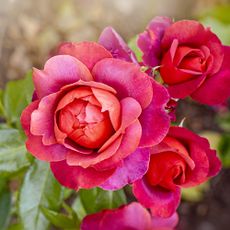Problems
If only things could always go right in the garden. The fact of the matter is, sometimes they don't. Pests, disease, environmental hazards and more can strike your plants. Learn what they are and how to prevent them here.
Explore Problems
Editor's Picks
-

Reed Grass Control & Tips For Removing Common Reeds
While a small patch of reeds may be an attractive addition to the landscaping, they spread so quickly that they'll take over the lawn if you don't take steps to kill them off. Read here for tips on controlling reed grass.
By Anne Baley
-

Is Ruellia Invasive: Tips On How To Get Rid Of Mexican Petunias
Pretty Mexican petunia, or Ruellia, has been designated as invasive in 9 states. Be sure to buy the right cultivars.
By Kristi Waterworth
-

What Is Stinkweed. Learn How To Kill Stinkweed Plants
Stinkweed is a smelly lawn weed with an odor similar to rotten garlic with a hint of turnip. It can take over your yard if you don't start a management program early in the season.
By Jackie Carroll
-

Tips For Managing Yellow Rattle Plants In The Landscape
Yellow rattle plant is an attractive wildflower that adds beauty to a naturalistic environment or a wildflower garden. However, the plant, also known as yellow rattle weed, spreads rapidly and can become highly invasive. Learn more here.
By Mary H. Dyer
-

Holes In The Leaves Of Your Plants? Common Causes & Fixes
Holes in the leaves of plants can be a bit distressing. From tiny holes to giant ones, “What is eating my plants?” is a gardening question heard around the world in spring and summer. Learning to diagnose and address leaf damage can help.
By Liz Baessler
-

Norfolk Island Pine Problems: Tackle Norfolk Island Pests & Diseases
While Norfolk pine can be a dream to grow both outdoors and inside, it is prone to pests and diseases. We outline the best ways to tackle (and prevent) key Norfolk Island pine problems
By Teo Spengler
-

What Causes Brown Edges Or Brown Tips On Leaves?
When you see brown tips on plants and leaves, it’s time to investigate. Of all the possible reasons for brown tips on leaves, one of them will probably become obvious. Put on your Sherlock Holmes hat.
By Heather Rhoades
-

Simple Slug Trap - The Easiest Way To Get Rid Of Slugs & Snails
If your plants are getting chewed up in the night, you may want to make a DIY slug trap to attract and isolate them.
By Amy Grant
-

Explore The World Of Insects With “Bugging Out”
Understanding the amazing benefits of insects can change our perspective on how important they are and maybe change how we treat them.
By Bonnie L. Grant
-

How To Prevent, Identify & Treat Root Rot In Houseplants
Root rot treatment is easy if you know for sure that it's the culprit. Plants can display similar symptoms with both too much or too little water.
By Heather Rhoades
-

Find Out How To Keep Animals Out Of The Garden With No Fence
Although our wildlife matters, there will be times when you need to know how to keep animals out of the garden. Luckily, there are ways to protect your plot without a fence
By Tonya Barnett
-

South American Palm Weevil: Identification & Control Methods
South American palm weevils are small bugs that can cause big damage.
By Teo Spengler
-

Yellow Starthistle: Identification & Control Methods
Yellow Starthistle is a noxious invasive weed that steals nutrients and moisture from other plants and is poisonous to horses.
By Susan Albert
-

What to Know As You Learn How To Create a Butterfly Garden
Learning the ins-and-outs of creating a butterfly garden can be a daunting task for gardeners of all skill levels. That’s why we’re on a mission to make your journey less intimidating.
By Gardening Know How
-

Invasive Black Swallow Wort: Control And ID
Black swallow-wort is invasive and harmful to ecosystems and monarchs. Learn how to identify and eradicate it!
By Mary Ellen Ellis
-

Phragmites: Native Vs. Invasive Varieties
Some phragmites, also known as common reeds, can be highly invasive. It’s good to know which ones to avoid and remove.
By Susan Albert
-

Toxic Plants To Dogs - Plants That Are Poisonous To Dogs
Dogs love to chew on things, whether they're good for them or not. Knowing what plants are poisonous to dogs can go a long way in keeping your pet safe.
By Nikki Tilley





